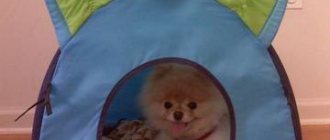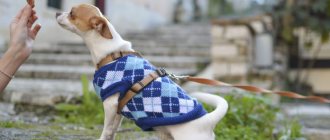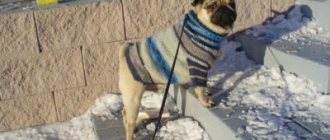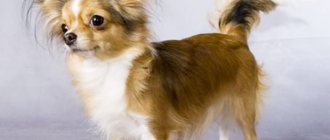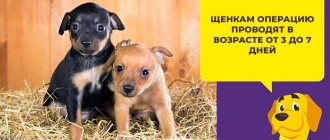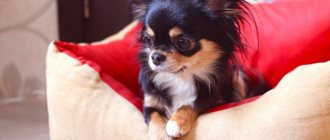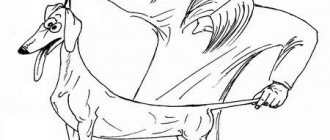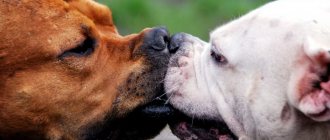Appearance
Vizslas are very stately and graceful dogs. Their physique is graceful, but at the same time muscular. The height at the withers of representatives of the breed can reach 61 cm, and the weight reaches thirty kilograms.
This dog has strong legs and a wide chest. The tail is set low. It is usually docked at one third of the length. The eyes are brown (slightly darker than the color itself). The muzzle is rectangular with hanging ears.
The standard colors for this breed are reddish-golden. There may also be a white spot on the chest, and light markings are allowed on the tips of the fingers. Brown and reddish colors are considered defective.
According to the structure of their coat, Vizslas are divided into short-haired and wire-haired. The latter have longer and stiffer fur, but it does not fit tightly to the body. Short-haired Vizslas have thick, smooth hair that fits well to the body.
Is it difficult to train a Hungarian Vizsla?
Holly and I went through OCD. I didn’t expect that we would pass it, because it seemed to me that this was a dog from the category of “it flew in one ear, flew out of the other.” However, we passed the test. And we have the corresponding certificate. This helps a lot in life - the owner’s word has weight for her.
In the photo: Hungarian Vizsla Holly
Moreover, OKD is not just passing by. These are many difficult situations: cyclists, crowds of people, cars, etc. For example, one of the tests was to leave the dog at the door and enter the building, while various people approached Holly and tried to get some kind of reaction from her. But she sat and looked at the door; nothing else existed for her.
We also do coursing (running after a mechanical hare). Holly really likes it, for her it is an opportunity to “drain” the energy accumulated over the week.
From experience: Holly is motivated by toys. A treat is good, but a toy is better. She absolutely loves being played with.
On a scale of 10, the Hungarian Vizsla is trainable, as it seems to me, at 8. She is very smart, capable, loves to work, does not get tired and follows commands with a bang.
In the photo: Hungarian Vizsla Holly
Character
The name of the breed “Vizsla” translates as “to search.” This dog really has a keen sense of smell. He follows the trail perfectly. The Vizsla is very hardy, tolerates difficult climatic conditions well, holds an excellent stance and works excellently in swampy thickets and rough terrain.
The Vizsla gets along well with children and can become a real nanny for them. So you can, without fear, leave your kids with an affectionate, kind and caring dog, who will not only not offend them, but will also protect them if necessary.
But the Vizsla is especially devoted to its owner. In addition to hunting work, such a dog can be both a watchman, barking at strangers, and a playful companion who will travel with you around the world.
Nutrition
No special diet is required. The most important thing is to provide this active dog with enough energy. You can feed the Vizsla with both natural food and prepared food.
With natural feeding:
- 70–75% of the diet should be cooked meat;
- 10–15% - carbohydrates (barley, oatmeal, buckwheat, rice);
- 5–10% - vegetables and herbs.
Ready-made food for Vizslas should be of the highest quality and balanced, not lower than super premium or holistic class, preferably high-calorie and intended for hunting dogs.
In addition, it is most useful to give additional vitamin complexes (consultation with a veterinarian is required). You need to feed your dog strictly at the same time twice a day (morning and evening). Outside of feeding, the dog should only have access to water. It is not recommended to feed your dog before a walk or active pastime to prevent gastric volvulus.
Meat is the basis of a dog’s diet
Keeping a dog
Keeping such a dog is not particularly difficult, as it is easy to care for and balanced. This dog will never bother its owner: it is quite enough for him to simply be near his owner.
If you don't go hunting with your dog often, he will need an active walk. The Vizsla will be very grateful to you for walking and jogging together. She also loves sports.
You cannot keep such a dog on a chain or in a kennel, as it is a domestic dog and requires special care and attention. This dog doesn't do well being alone. So try not to leave him alone all day.
The Vizsla can be kept both in an apartment and in a house, in a fenced yard. At the same time, do not forget about regular long walks with the opportunity to frolic without a leash.
Breed traits
Breed traits (on a 5-point scale)
| Vizsla Hungarian Shorthair | |||
| Activity | in the house | 3.9 | |
| on the street | 4.8 | ||
| Obedience | training | 3.9 | |
| strangers | 4.6 | ||
| Domination | in family | 2.1 | |
| over dogs | 2.5 | ||
| Defending your territory | from people | 2.5 | |
| from dogs | 2.3 | ||
| Sociability | in family | 4.8 | |
| with strangers | 3.6 | ||
| with dogs | 3.6 | ||
| Concentration | in family | 1.3 | |
| in front of strangers | 2.4 | ||
| with dogs | 2.5 | ||
| Aggressiveness | in family | 1.1 | |
| to strangers | 1.9 | ||
| to the dogs | 1.6 | ||
| to cats | 2.1 | ||
| Family behavior | calmness | 4.5 | |
| demand for affection | 4.6 | ||
| excitability | 4 | ||
| playfulness | 4.6 | ||
| excessive barking | 1.8 | ||
| behavioral breakdowns | 2 | ||
| Tolerance for children | up to 4 years | 3.3 | |
| over 4 years old | 4.1 | ||
| Institutional use | watchman | 3.5 | |
| bodyguard | 1.9 | ||
This breed is often compared to the following dog breeds: Weimaraner, German Shorthaired Pointer, Rhodesian Ridgeback, English Pointer, Belgian Shepherd Groenendael.
The photo shows what a Hungarian Vizsla looks like:
Training
Raising and training a representative of the Hungarian Vizsla breed is a very pleasant process in all respects. Training this dog will not give you much trouble. Keep in mind that the breed is a very sensitive breed, so positivity and encouragement should be your primary focus when training. This dog is sociable when working, it likes to please its owner. To raise such a dog, the owner does not need to be harsh; strength of character and, of course, perseverance will be enough, since Vizslas are smart dogs. They can learn to manipulate you in order to take a leadership position in the house.
Another feature of the breed is its love of water. Vizslas are excellent swimmers. Therefore, from childhood, do not deny your pet the pleasure of swimming.
How to feed a Hungarian Vizsla?
Hungarian Vizslas are gluttons who can swallow anything that is bad.
From experience: When we got Holly, she didn't bark. And we heard the first “woof” when she really wanted to see what was so attractive lying there, high on the table. Then Holly started to grow and realized that she could run her tongue along the edge of the table. She knows that she can’t take it from the table - and she won’t take it. But at least sniff or lick - she can’t resist.
Holly has a sister who we say is “tongue incontinent.” Anything that can be licked off, she will definitely lick it off!
Holly eats absolutely everything. We have her on a natural diet (beef, cereal, vegetables, fruits, cottage cheese). But most of all, the dog loves boiled udders - Holly is ready to do anything for it.
In the photo: Hungarian Vizsla Holly
Price
When selling dogs, the kennel guarantees their pedigree, their health and suitability for breeding. Throughout the dog’s life, breeders from nurseries are ready to answer many questions, help with participation in exhibitions, and in selecting a groom/bride.
If you buy a dog second-hand, then such help and guarantee will no longer be available. It is advisable to apply for puppies only to nurseries that specialize in this breed. For less than 25 thousand rubles, you can only buy a puppy secondhand, without documents or with a breed defect.
The price corresponding to the breed characteristics and qualities of the Hungarian Vizsla, with ready-made documents and vaccinations, starts from 30 thousand rubles. Show-class puppies, promising for a show career, born from champion parents, are sold for 60-70 thousand rubles.
Brief history of origin
Hungarian Vizslas are descended from pointing dogs that appeared in Hungary in the 9th-11th centuries. at that time the country was not yet autonomous and was considered part of the Roman province of Pannonia. The Magyar tribes that lived in this territory hunted for a living and, for baiting game, bred sandy-colored dogs that were well versed in the terrain and easily tolerated the damp climate.
Together with the nomads, the cops moved from place to place and gradually migrated to neighboring regions. With their grace and dexterity, they conquered the Hungarian hunters and they, wanting to improve the characteristics of the Magyar dogs, began to cross them with eastern pointers. It is believed that Russian greyhounds and Salukis took part in the formation of the breed.
As a result of random and purposeful matings, hunting dogs with golden fur and an established genotype were born. They quickly gained a reputation as versatile hunters, capable of working in woods, fields and water, and were used for falconry and gun hunting.
In the 18th century, breeding of the Hungarian pointer was brought under control. The center of work to improve the parameters of the Vizsla was the Hungarian city of Zaingroce, and the initiator of the creation of a new breeding program was the local breeder Zai. During selection, the blood of Hanoverian hounds, pointers, shorthaired pointers and even poodles was infused into the pointer.
From the end of the 19th century, field trials began in Hungary, in which Vizslas took part. At that time, representatives of other gun breeds were actively involved in the development of the Hungarian pointer.
Purebred Vizsla breeding began in 1920. And 16 years later, the Hungarian pointer received official recognition from the International Canine Federation.
Health
In their general population, Hungarian Vizslas are distinguished by a strong immune system and good endurance. They are not susceptible to major health problems. It is not uncommon for dogs to live up to 14 years and not get sick at all. They do not have breed-specific hereditary diseases. From this point of view, representatives of the breed are quite protected.
In addition to femoral dysplasia, some dogs have skin allergies to certain foods, particularly soybeans. Allergy is the body’s canine response to environmental allergens and food products. It can cause dermatological reactions ranging from pimples to more severe conditions. As for dysplasia, the problem is solved with the help of an examination, which is carried out before confirming the standard in order to obtain pedigree individuals with good pedigree. Animals that have not received status A or B, according to the official classification, do not undergo confirmation.
Vizslas get ear infections due to their long, closed ears. Common sense dictates that they should be kept properly clean. Most often, cleaning is carried out twice a week, using products designed specifically for dogs.
Like all canines with a deep and narrow chest, these dogs can experience gastric volvulus (dowsing syndrome). This condition requires immediate veterinary intervention. After providing first aid, it is important to fix the stomach in its anatomically normal position so as to avoid problems in the future. Often the intervention is carried out in two stages.
Returning from a hunt, it is important to carefully examine the dog’s skin where there are folds. The fact is that with the beginning of the hunting season, foreign plant particles, for example, thorns, can get stuck in these places. As for hunting, individuals who have reached sexual maturity, that is, the end of the growth period, are allowed to take part in the event. This will help avoid osteoarticular problems
